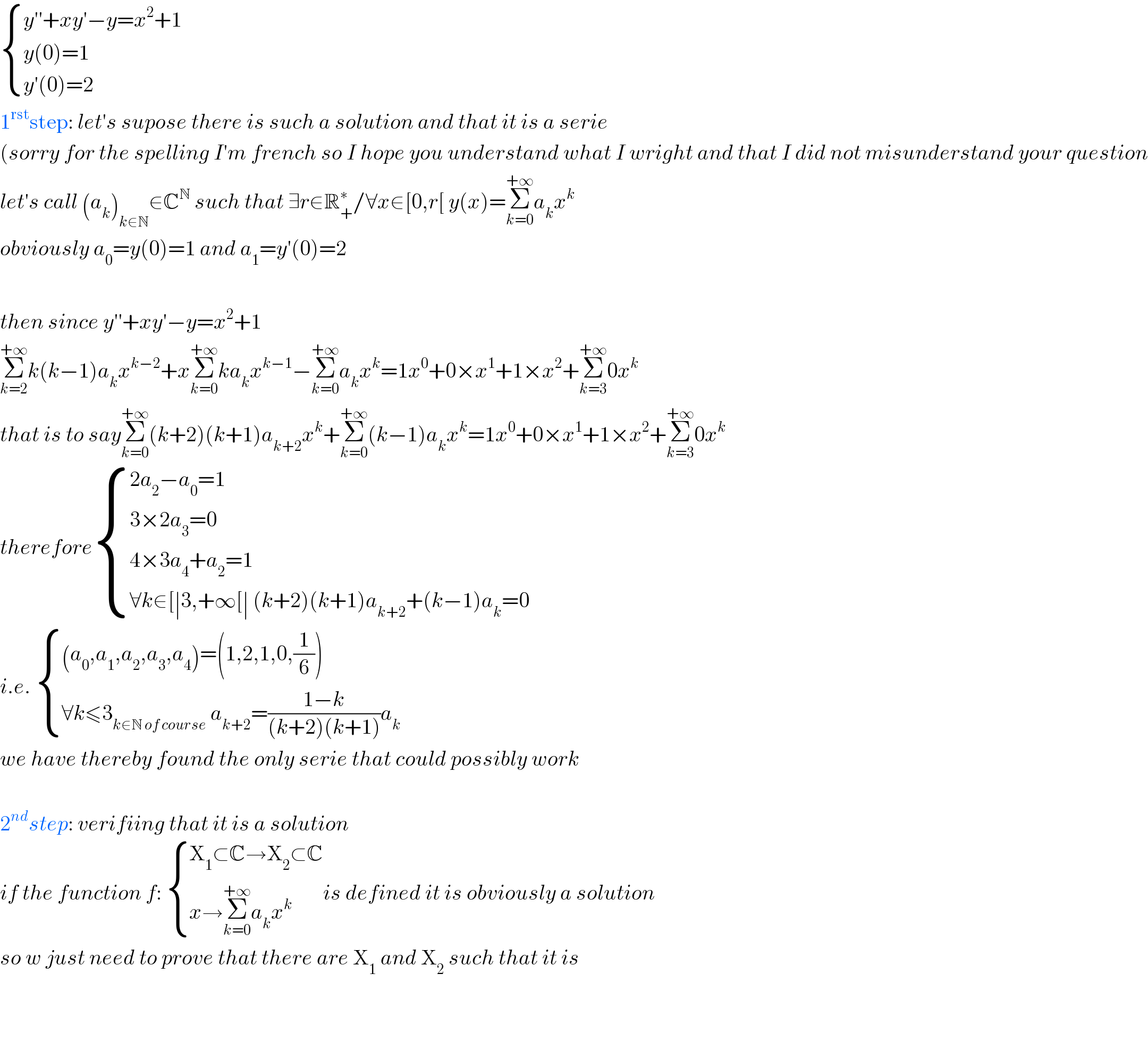
Previous in Differential Equation Next in Differential Equation
Question Number 119472 by Engr_Jidda last updated on 24/Oct/20

Answered by Sach last updated on 24/Oct/20

$$\begin{cases}{{y}''+{xy}'−{y}={x}^{\mathrm{2}} +\mathrm{1}}\\{{y}\left(\mathrm{0}\right)=\mathrm{1}}\\{{y}'\left(\mathrm{0}\right)=\mathrm{2}}\end{cases} \\ $$$$\mathrm{1}^{\mathrm{rst}} \mathrm{step}:\:{let}'{s}\:{supose}\:{there}\:{is}\:{such}\:{a}\:{solution}\:{and}\:{that}\:{it}\:{is}\:{a}\:{serie} \\ $$$$\left({sorry}\:{for}\:{the}\:{spelling}\:{I}'{m}\:{french}\:{so}\:{I}\:{hope}\:{you}\:{understand}\:{what}\:{I}\:{wright}\:{and}\:{that}\:{I}\:{did}\:{not}\:{misunderstand}\:{your}\:{question}\right. \\ $$$${let}'{s}\:{call}\:\left({a}_{{k}} \right)_{{k}\in\mathbb{N}} \in\mathbb{C}^{\mathbb{N}} \:{such}\:{that}\:\exists{r}\in\mathbb{R}_{+} ^{\ast} /\forall{x}\in\left[\mathrm{0},{r}\left[\:{y}\left({x}\right)=\underset{{k}=\mathrm{0}} {\overset{+\infty} {\sum}}{a}_{{k}} {x}^{{k}} \right.\right. \\ $$$${obviously}\:{a}_{\mathrm{0}} ={y}\left(\mathrm{0}\right)=\mathrm{1}\:{and}\:{a}_{\mathrm{1}} ={y}'\left(\mathrm{0}\right)=\mathrm{2} \\ $$$$ \\ $$$${then}\:{since}\:{y}''+{xy}'−{y}={x}^{\mathrm{2}} +\mathrm{1} \\ $$$$\underset{{k}=\mathrm{2}} {\overset{+\infty} {\sum}}{k}\left({k}−\mathrm{1}\right){a}_{{k}} {x}^{{k}−\mathrm{2}} +{x}\underset{{k}=\mathrm{0}} {\overset{+\infty} {\sum}}{ka}_{{k}} {x}^{{k}−\mathrm{1}} −\underset{{k}=\mathrm{0}} {\overset{+\infty} {\sum}}{a}_{{k}} {x}^{{k}} =\mathrm{1}{x}^{\mathrm{0}} +\mathrm{0}×{x}^{\mathrm{1}} +\mathrm{1}×{x}^{\mathrm{2}} +\underset{{k}=\mathrm{3}} {\overset{+\infty} {\sum}}\mathrm{0}{x}^{{k}} \\ $$$${that}\:{is}\:{to}\:{say}\underset{{k}=\mathrm{0}} {\overset{+\infty} {\sum}}\left({k}+\mathrm{2}\right)\left({k}+\mathrm{1}\right){a}_{{k}+\mathrm{2}} {x}^{{k}} +\underset{{k}=\mathrm{0}} {\overset{+\infty} {\sum}}\left({k}−\mathrm{1}\right){a}_{{k}} {x}^{{k}} =\mathrm{1}{x}^{\mathrm{0}} +\mathrm{0}×{x}^{\mathrm{1}} +\mathrm{1}×{x}^{\mathrm{2}} +\underset{{k}=\mathrm{3}} {\overset{+\infty} {\sum}}\mathrm{0}{x}^{{k}} \\ $$$${therefore\begin{cases}{\mathrm{2}{a}_{\mathrm{2}} −{a}_{\mathrm{0}} =\mathrm{1}}\\{\mathrm{3}×\mathrm{2}{a}_{\mathrm{3}} =\mathrm{0}}\\{\mathrm{4}×\mathrm{3}{a}_{\mathrm{4}} +{a}_{\mathrm{2}} =\mathrm{1}}\\{\forall{k}\in\left[\mid\mathrm{3},+\infty\left[\mid\:\left({k}+\mathrm{2}\right)\left({k}+\mathrm{1}\right){a}_{{k}+\mathrm{2}} +\left({k}−\mathrm{1}\right){a}_{{k}} =\mathrm{0}\right.\right.}\end{cases}} \\ $$$${i}.{e}.\:\begin{cases}{\left({a}_{\mathrm{0}} ,{a}_{\mathrm{1}} ,{a}_{\mathrm{2}} ,{a}_{\mathrm{3}} ,{a}_{\mathrm{4}} \right)=\left(\mathrm{1},\mathrm{2},\mathrm{1},\mathrm{0},\frac{\mathrm{1}}{\mathrm{6}}\right)}\\{\forall{k}\leqslant\mathrm{3}_{{k}\in\mathbb{N}\:{of}\:{course}} \:{a}_{{k}+\mathrm{2}} =\frac{\mathrm{1}−{k}}{\left({k}+\mathrm{2}\right)\left({k}+\mathrm{1}\right)}{a}_{{k}} }\end{cases} \\ $$$${we}\:{have}\:{thereby}\:{found}\:{the}\:{only}\:{serie}\:{that}\:{could}\:{possibly}\:{work} \\ $$$$ \\ $$$$\mathrm{2}^{{nd}} {step}:\:{verifiing}\:{that}\:{it}\:{is}\:{a}\:{solution} \\ $$$${if}\:{the}\:{function}\:{f}:\:\begin{cases}{\mathrm{X}_{\mathrm{1}} \subset\mathbb{C}\rightarrow\mathrm{X}_{\mathrm{2}} \subset\mathbb{C}}\\{{x}\rightarrow\underset{{k}=\mathrm{0}} {\overset{+\infty} {\sum}}{a}_{{k}} {x}^{{k}} }\end{cases}{is}\:{defined}\:{it}\:{is}\:{obviously}\:{a}\:{solution} \\ $$$${so}\:{w}\:{just}\:{need}\:{to}\:{prove}\:{that}\:{there}\:{are}\:\mathrm{X}_{\mathrm{1}} \:{and}\:\mathrm{X}_{\mathrm{2}} \:{such}\:{that}\:{it}\:{is} \\ $$$$ \\ $$$$ \\ $$
Commented by Sach last updated on 24/Oct/20

$${it}\:{is}\:{quite}\:{obvious}\:{that}\:\left({a}_{\mathrm{2}{k}} \right)\:{and}\:\left({a}_{\mathrm{2}{k}+\mathrm{1}} \right)\:{are}\:{of}\:{alternating}\:{signs}\:{and}\:{both}\:{decrease}\:{towards}\:\mathrm{0} \\ $$$${therefor}\:{we}\:{get}\:{the}\:{result}\:{we}\:{wanted}! \\ $$$$\left({sorry}\:{that}\:{I}\:{sent}\:{the}\:{answer}\:{without}\:{that}\:{last}\:{bit}\right. \\ $$$$\left.{I}\:{hope}\:{you}\:{could}\:{understand}\:{me}\:{and}\:{that}\:{I}\:{solved}\:{your}\:{problem}\right) \\ $$
Commented by Engr_Jidda last updated on 24/Oct/20

$$\mathrm{yes}\:\mathrm{sir},\:\mathrm{thank}\:\mathrm{you}\:\mathrm{so}\:\mathrm{much} \\ $$
